Tourists Revel In Rich Khmer Culture

By Văn Châu
At first, I thought it would take only one day to sample the best of Trà Vinh, a coastal province in the Cửu Long (Mekong) Delta, but I was quickly proven wrong.
Hundreds of ancient trees and a fascinating Khmer culture with at least 140 Khmer pagodas as well as the Ao Bà Ôm (Bà Ôm Pond) relic site are just a few of the many highlights of the area.
Surrounded by the Tiền (Front) and Hậu (Rear) rivers, the province has a long coastline stretching 65km along the East Sea. To the north are Bến Tre and Vĩnh Long provinces and to the west is Sóc Trăng Province.
The main city, Trà Vinh, is known as “Green City” and is home to over 13,690 trees. Of these, about 800 are more than 100 years old, including tamarinds, the timber tree Dầu (dipterocarpus alatus) and the timber and medicine tree hopea odorate.
Blessed with natural sights that can soothe the weary soul of an urban traveller, the area is perfect for boat tours along canals and rivers, swimming in the sea, ethnic culture tours, and extraordinary local food specialties.
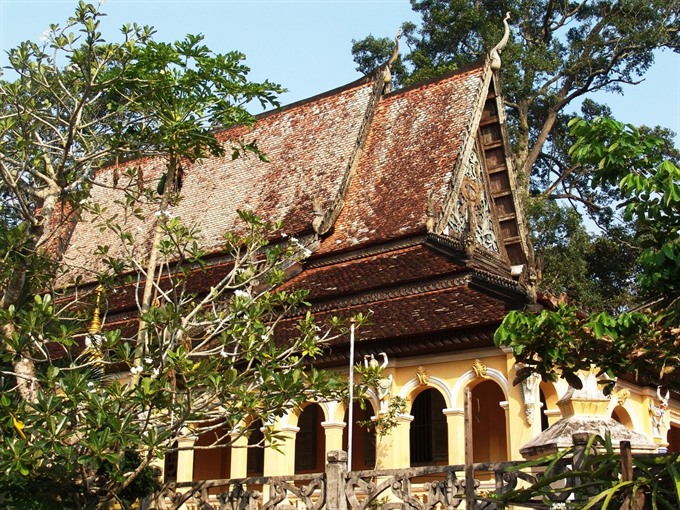 |
| Ancient: The tranquil beauty of Ang Pagoda. — File Photo |
If you visit in mid-November to mid-December, the Ok Om Bok Festival, also called the Festival of Worshipping the Moon, takes place at the Ba Om Pond relic site.
Kim Ngọc Thái, deputy chairman of the province’s People’s Committee, said that the Ok Om Bok is one of the main traditional Khmer festivals in the south besides the Sene Dolta and Chol Chnam Thmay festivals.
The joyful and festive Ok Om Bok event has been recognised as a National Intangible Cultural Heritage by the Vietnamese government.
The one-week festival includes cultural and sports events, trade fairs offering local specialties, traditional competitions such as tug-of-war and crossing of bamboo bridges, and a souvenir design contest.
But the standout activity is the exciting and colourful Ghe Ngo (Khmer boat) race on Bà Ôm Pond (which is actually as big as a lake)
Six rowing teams with nearly 400 athletes from different districts and cities in the province compete in a race that is seen as both a way to express solidarity and a traditional ritual to see off the God of Water to the ocean after the growing season.
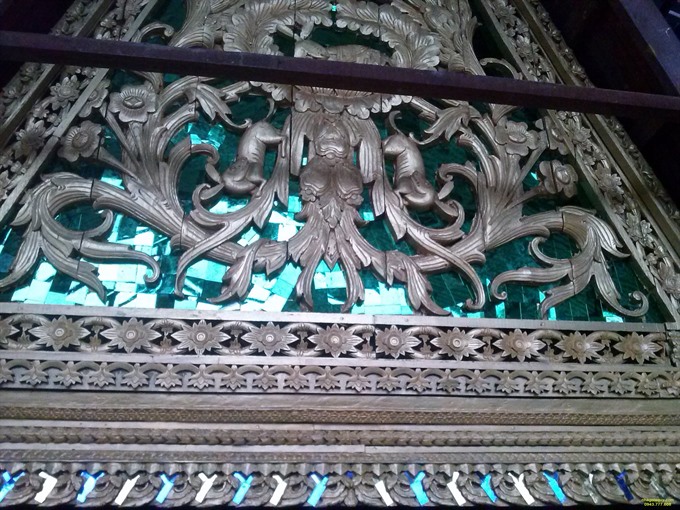 |
| Fine carving: Part of the timberwork inside Ang Pagoda. — File Photo |
The Khmer also view the race as a religious ritual in which they commemorate the Snake God, Naga, who turned into a lump of wood to help the Buddha cross the river, according to legend.
The Khmer believe the moon is a god who controls the weather and crops throughout the year. Every year, the festival takes place under a full moon in the 10th lunar month during the transition from the rainy to the dry season and from the growing to the harvest season.
The festival is also celebrated in villages throughout the province, mostly in gardens at local pagodas. On the occasion, the Khmer people provide offerings of farm products to thank the gods for favorable weather and bountiful harvests.
Ang Pagoda, also called Angkorajaborey Pagoda, is an ancient southern Khmer-style pagoda located 7km from the centre of Trà Vinh City. It covers a 4-ha area and is surrounded by old trees near the Bà Ôm Pond.
The pagoda has been recognised as a national relic by the Ministry of Culture, Sports and Tourism.
For the Khmer, pagodas are spiritual and cultural spaces that express the life of the locals. They are typically built in an architectural style imbued with the cultural characteristics of Theravada. one of the three main traditions in Buddhist practice and philosophy. It is taught in the Pali language, the same language spoken by the Buddha.
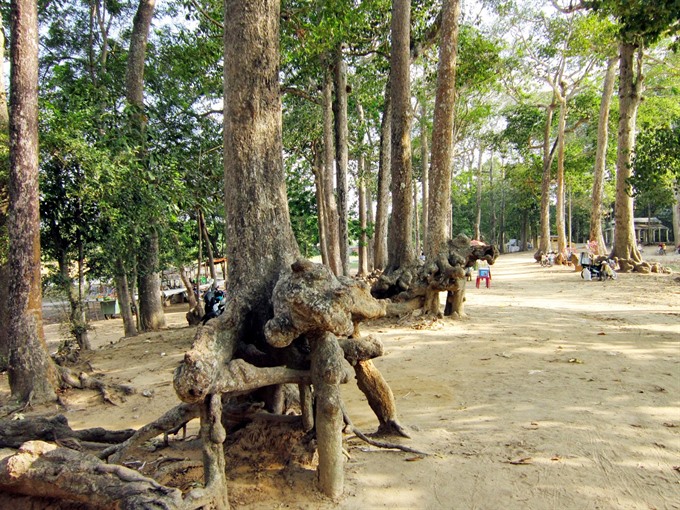 |
| Another world: The garden at Ang Pagoda. — File Photo |
The Khmer believe that the Buddha blesses and protects them, so followers donate time, money and effort to build pagodas in their hamlets.
More than one million Khmer live in southern Việt Nam, which has a total of 600 Khmer pagodas. Some of them have existed for several centuries and have been recognised as national architectural relics, including the pagodas of Ang, Mẹt, Hang and Dơi.
The pagodas are always built on large areas surrounded by Dầu (Dipterocarpus alatus) trees, Palmyra palms or green cajuput forests.
A panoramic view of a typical Khmer pagoda includes a monastery, gate, fence, wall, main chamber, towers containing the ashes of dead monks, and the Sala, the place where monks and the Khmer gather to prepare for important ceremonies.
The main chamber of the Ang Pagoda, the most important part of the structure, is located in the centre and faces east. It is designed with a multi-layered roof decorated with four curved dragon’s tails on four of the roof’s corners.
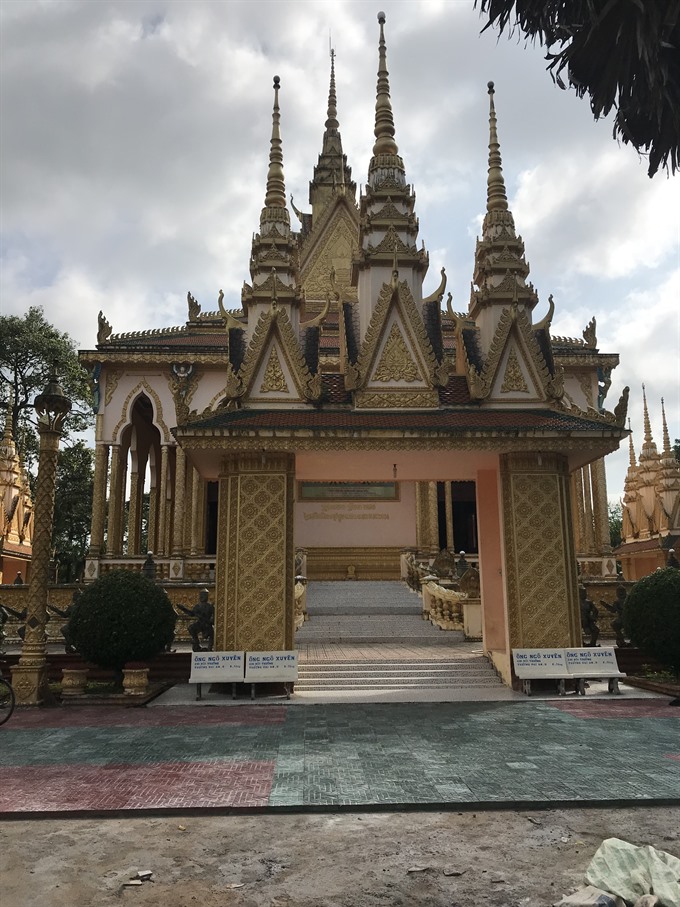 |
| Central: The pagoda’s main chamber, the most important part of the structure, is located in the centre of Khmer pagodas. — VNS Photo Văn Châu |
Decorative reliefs on the pagoda’s walls include a fairy, statues of divine Krud birds, the ogress Yeak wearing armor, and the head of the Bayon with four faces, all expressing the spirit of the Khmer people.
The corridor outside the main chamber is decorated with Naga curving around the terrace that represent cruel forces subdued by the Buddha.
The Khmer, who account for 30 per cent of the province’s population, have enriched the local cuisine with traditional ingredients and distinctive flavours.
Bún Nước Lèo (noodle soup) is one of the most well-known. It consists of snakehead fish, roast pork and shrimp, with the essential “mắm bò hóc” (bò hóc sauce) to enrich the boldness and brackishness of the soup.
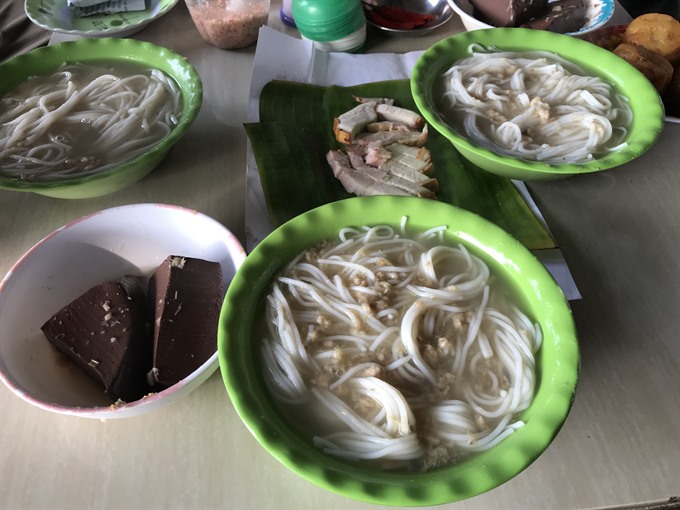 |
| Mekong food: A bowl of Bún Nước Lèo comes with snakehead fish, roast pork, shrimp and a special sauce called “mắm bò hóc” (bo hoc sauce).— VNS Photo Văn Châu |
The noodles are made of rice flour to enhance sweetness, but to make the soup complete, you must add herbs such as boiled full-grown peas, chives and sliced banana leaves. A bowl of bún nước lèo costs an affordable VNĐ20,000-25,000 (US$0.8-1).
Other specialities include bánh canh Bến Có (Bến Có soup noodles), Trà Cuôn sticky rice cake, Dừa sáp Cầu Kè (Cầu Kè waxed coconut) and Xuân Thạnh Wine.
In the centre of Trà Vinh City are many hotels with prices ranging from VNĐ300,000 to VNĐ1 million a night ($13-$45).
Located about 200km away from HCM City and 100km from Cần Thơ City, Trà Vinh can be reached by bus for VNĐ100,000-150,000 ($4.50-70) each way or by motorbike. It takes about three to four hours from HCM City and about two hours from Cần Thơ.
Within Trà Vinh City, visitors can rent a motorbike from their hotel for about VNĐ150,000 ($7) a day or take a taxi to tour the city. — VNS
Submarine DeepView24 To Serve Visitors At Vinpearl Nha Trang
US dollar billionaire Phạm Nhật Vượng, Chairman of Vingroup, will put into operation DeepView 24, a spectacularl... Read more
Bánh Khọt A Must-try At Vũng Tàu Beach
Bánh Khọt (mini savory pancake) is a great breakfast dish that visitors must try when staying at Vũng Tàu beach... Read more
Explore The First Museum In Southern Việt Nam
The HCM City Museum of History is located at Nguyễn Bỉnh Kiêm Street in District 1, set beside Saigon Zoo and Bota... Read more
Explore Hidden Waterfall In Central Việt Nam
Tà Puồng Waterfall is one of Việt Nam Central’s most impressive natural sights, with an unspoilt beauty. Read more
Bat Pagoda, Home Of Thousands Of Bats In Mekong Delta
The Cửu Long (Mekong) Delta is home oi about 600 Khmer pagodas and each temple has a unique feature. The Bat Pago... Read more
100-year-old Bửu Sơn Pagoda Rests On One Pillar
The 100-year-old Bửu Sơn Pagoda in Đồng Nai Province, built in the 18th century, rests on only one pillar. Read more

